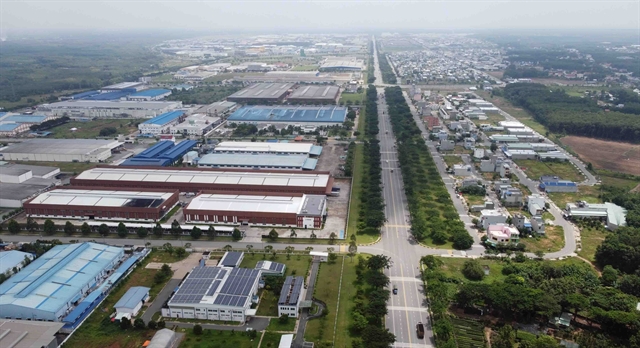Merging provinces, cities is driver for industrial property development
The merger of administrative units will not simply adjust boundaries, but also aims to streamline the management apparatus and enhance competitiveness among localities.

Adjusting provincial and municipal administrative boundaries is expected to spark the development of large-scale industrial-urban zones, attracting more international investors.
The merger of administrative units will not simply adjust boundaries, but also aims to streamline the management apparatus and enhance competitiveness among localities.
According to Thomas Rooney, associate director of Industrial Services at Savills Hà Nội, if carried out systematically, this process will help initiate the development of integrated urban-industrial ecosystems to attract more international investors who are becoming more selective with investment destinations.
The expansion of administrative boundaries will enable provinces to plan more large-scale industrial zones, offering more business options. With the increase in available land, domestic and international enterprises will have greater access to suitable sites to build factories, thereby mitigating industrial land shortages in high-demand localities.
After the mergers, the larger provinces will have the foundation to delineate zones more clearly, thereby facilitating the development of specialised industrial parks or clusters. Examples include supporting industrial parks or specific-sector parks that supply components and parts for major manufacturing sectors or specific industries, such as automotive or semiconductor sectors.
“Provinces which have already been standout destinations for investment will benefit from mergers and planning coordination by complementing each other in infrastructure, workforce and development strategy. With a larger scale, these provinces can achieve higher standards in infrastructure and management, strengthening their position in the global value chain,” Rooney said.
According to Trương Gia Bảo, vice chairman and general secretary of the Vietnam Industrial Real Estate Association, the Government’s policy of merging provinces and cities is designed to optimise regional planning and boost economic development. This strategic move is seen as a new growth engine for industrial real estate, particularly in key economic zones.
Bảo believes the mergers will streamline planning for industrial parks, logistics hubs and urban development, paving the way for the creation of new industrial centres.
Next-generation industrial hubs
A unified regional development strategy will also enhance the appeal of established industrial hubs like Bắc Ninh, Hải Phòng and Thái Nguyên, making them more attractive to investors.
In the north, the merged regions are expected to evolve into high-tech manufacturing centres. Meanwhile, in the south, the conversion of rubber plantations will release significant new land for industrial development.
Experts say that if these administrative mergers are accompanied by strategic infrastructure investments — particularly in belt roads, seaports, airports and digital infrastructure — industrial development will no longer be constrained by provincial boundaries.
This will allow businesses to tap into broader labour markets and optimise operational costs. Improved inter-regional connectivity also supports a shift away from overcrowded industrial zones, where land supply is tightening and costs are rising.
Emerging localities with ample land reserves, competitive rental prices and upgraded infrastructure will be well-positioned to become Việt Nam’s next-generation industrial hubs.
Adjusting administrative boundaries will inevitably impact various government functions, from land use planning and investment licensing to legalities surrounding the environment and construction.
Rooney said that short-term business discomfort might arise due to changing the point of contact and misalignment in the merged localities. However, this would present a major opportunity to rebuild a more transparent and efficient regulatory framework in the long run.
Better coordination and unified procedures within the new administrative zones would help save time, reduce compliance costs and improve investor confidence.
Global trends
The Savills expert added: “For industrial real estate, where stability and clarity in planning are critical, the unification of procedures and policies will pave the way for large-scale industrial zones integrating logistics infrastructure, satellite towns and inter-regional transport links.”
One key impacted area is the workforce, a foundational layer of industrial real estate competitiveness. Changes in administrative boundaries can affect workers’ housing plans, administrative registration and transport connections.
The development of inter-regional infrastructure also drives the shift away from traditional industrial markets, where supply is limited and investment costs are rising. Emerging localities with abundant, affordable land and improved infrastructure will be able to become new industrial hubs.
Vũ Minh Chí, senior manager of Industrial Services at Avison Young Vietnam, said that in the early months of this year, 14 new industrial park projects were licensed in Cần Thơ, Hải Phòng, Thái Nguyên, Bình Phước, Bắc Giang, Hải Dương, and Bà Rịa Vũng Tàu. The projects span over 4,100 hectares of land.
These projects are expected to significantly expand Việt Nam’s industrial land supply, attract both domestic and foreign investment, create jobs and spur local economic growth.
Many of these industrial parks are being developed under a modern, high-tech and sustainable model, aligning with global trends in green and smart industrial development.
Việt Nam is also emerging as a hotspot in Southeast Asia’s rapidly growing data centre market. One standout example is Saigon Asset Management’s US$1.5 billion investment in a 150MW data centre in Bình Dương.
Chí highlighted the growing demand for data storage and processing from global tech companies, emphasising Việt Nam’s advantages, such as a strategic location, cost-efficiency and favourable investment policies.
These factors position the country as a potential regional hub for data centres, according to Chí. However, to fully realise this potential, further enhancements in power infrastructure, connectivity and sector-specific incentives are needed. VNS





